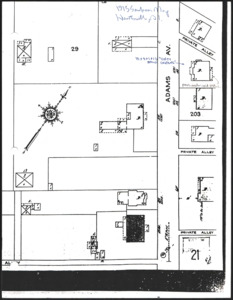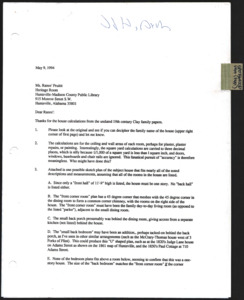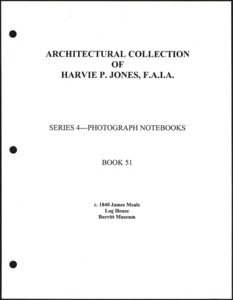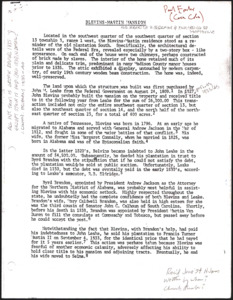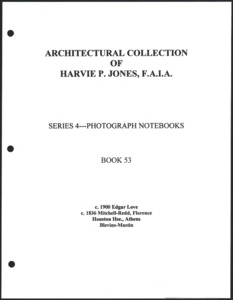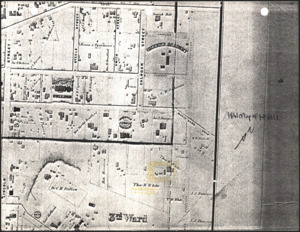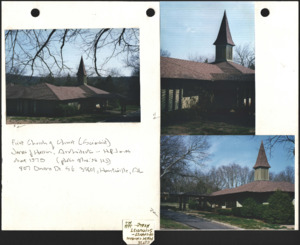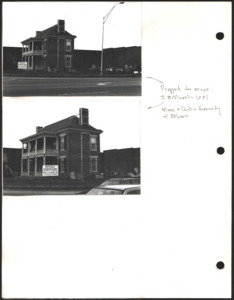
Browse Items (212 total)
Sort by:
-
Architecture notebook 50: Gray Gables, at 509 Adams St., Huntsville, Alabama.
"Gray Gables," built in 1893 by H. Poole. The front was altered in 1916 following a fire. Victorian style, originally had a two-story enclosed porch. Located at 509 Adams St., Huntsville, Alabama. -
Architecture notebook 50: McMurtrie Residence, from Rehobeth to Huntsville, Alabama.
The McMurtrie Residence, built c. 1850s. Moved from Rehobeth, Alabama, to Little Cove Road, Huntsville, Alabama c. 1990. -
Architecture notebook 50: Spotswood House, at 111 Greene St., Huntsville, Alabama.
William E. Spotwood House, built in the early 1800s. Federal Period house with additions. The house was demolished, sometime after 1871. The house reconstruction notes here were mostly created through information found among the 1840 Clay Family Papers. Located at 111 Greene St., Huntsville, Alabama. -
Architecture notebook 51: Meals Log House, or the Meals-Spencer House, at the Burritt Museum, Huntsville, Alabama.
James Meals Log House, or the Meals-Spencer House, built c. 1840 in N. Limestone County, Alabama and restored at Burritt Museum in Huntsville, Alabama. Jesse James was rumored to have been at the wedding of Margaret Meals, daughter of James Meals, and Thomas Alexander Adkins in 1876 before the payroll robbery in Muscle Shoals. -
Architecture notebook 52: Hundley House, at 401 Madison St., Huntsville, Alabama.
The Hundley House, built 1900. Remodeled four times before it was bought in 1994 and restored. It has been used as a movie set and a funeral parlor before restoration. Located at 401 Madison St., Huntsville, Alabama. -
Architecture notebook 53: Blevins-Mastin House, at 3705 N. Parkway, Huntsville, Alabama.
The Blevins-Mastin house, built c. 1835 by John Blevins. Greek revival plantation house. The house was eventually owned by the Church of Christ and used as a church by removing the entrance hall. Original walls and doors were replaced when converted back to a house. The church offered the house to Alabama Constitutional Village in 1994 and relocated to Williams and Fountain Circle, Huntsville. Originally at 3705 N. Parkway, Huntsville, Alabama. -
Architecture notebook 53: Edgar Love House, at 111 Maple Ave., Huntsville, Alabama.
Edgar Love House, built c. 1900, moved from original site c. 1920s to Maple Ave. House was demolished by owners in 1995. Last located at 111 Maple Ave., Huntsville, Alabama. -
Architecture notebook 54: Cox-White-Faber House, at 312 White St., Huntsville, Alabama.
The Cox-White-Faber House, built c. 1836 in the Federal style by architect George Steele. At one time had several service buildings that contained the kitchen, servants' quarters, the stable, and more. Only one large service building remains, presumed to be the smokehouse. The house underwent expansions in 1844 and again a few years later. A Greek Revival trim was added in the mid-1800s. Located at 312 White St., Huntsville, Alabama. -
Architecture notebook 55: First Church of Christ (Scientist), at 807 Owens Dr., Huntsville, Alabama.
First Church of Christ (Scientist), built in 1975. Located at 807 Owens Dr., Huntsville, Alabama. -
Architecture notebook 55: Humphrey-Rogers House, at 502 West Clinton St., Huntsville, Alabama.
Humphrey-Roger House, built in 1848 as a two-story rectangular home. Expanded in 1861, 1898, and 1913 to include a double front porch, a side porch and entrance, and a back wing addition. The house endured several preservation perils before being donated to the Constitution Village by Coca-Cola and restored by Jones & Herrin, Architects between 1992 and 1996. Located at 502 West Clinton St., Huntsville, Alabama.
